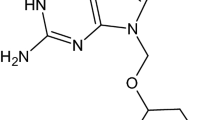Abstract
The polymorphic behaviour of the purine derivative MKS 492 was studied with investigations of suspensions of selected samples in different solvents and of samples obtained by crystallizations. The samples were analyzed by DSC, TG and X-ray diffraction. Six different crystalline modifications called A, B, B’, C, D and E and an amorphous form were identified. Four pure crystalline modifications, A, B, C and D have been manufactured and characterized by DSC, X-ray, IR, solubilities, densities, hygroscopicity and dissolution measurements. The four forms A, C, D and E are monotrop to the form B. The form B is enantiotrop to the form B’, which revealed the highest melting point of all known polymorphs. This form B’ is only stable at high temperature. Temperature resolved X-ray diffraction was very helpful for proper interpretation of the thermal events. The melting peaks of the forms A and C and the endothermic peak corresponding to the enantiotropic transition B into B’ occur in a narrow range of temperature. The form B which is the most stable one at room temperature has been chosen for further development. Quantitative methods to determine the content of the forms A, C and D in samples of form B or to determine the content of form A, B and D in form C have been developed by using X-ray diffraction. Limits of detection are 1 or 2%. For the quantitative determination of the amorphous fraction, X-ray diffraction and microcalorimetry are compared. For high amounts of the amorphous fraction, the X-ray diffraction method is preferred because it is faster. Microcalorimetry is very attractive for levels below 10% amorphous content. The lowest limit of detection is obtained by microcalorimetry, about 1%.
Similar content being viewed by others
References
International Conference on Harmonization (ICH) (1998) Guideline Specification Q6A, Decision Tree: Investigating the need to set acceptance criteria for polymorphism in drug substances and drug products.
D. Giron, Thermochim. Acta, 248 (1995) 1.
G. Berliz, R. Wintersteiger and W. Pacha, J. Chrom. B, 666 (1995) 368.
D. Giron and C. Goldbronn, Analusis, 7 (1979) 109.
C. Cakiryildiz, P. J. Metha, W. Rahmen and D. Schoenleber, J. Pharm. Sci., 64 (1975) 1692.
A. Burger and R. Ramberger, Mikrochim. Acta, II (1979) 259 and 273.
E. Marti, A. Geoffroy, O. Heiber and E. Scholl, Proc. of 5th Int. Conf. on Chemical Thermodynamics (1977) Ronneby, Sweden.
E. Marti, J. Thermal Anal., 33 (1988) 37.
D. Giron, P. Remy, S. Thomas and E. Vilette, J. Thermal Anal., 48 (1997) 465.
Rights and permissions
About this article
Cite this article
Giron, D., Piechon, P., Goldbronn, C. et al. Thermal Analysis, Microcalorimetry and Combined Techniques for the Study of the Polymorphic Behaviour of a Purine Derivative. Journal of Thermal Analysis and Calorimetry 57, 61–73 (1999). https://doi.org/10.1023/A:1010145125531
Issue Date:
DOI: https://doi.org/10.1023/A:1010145125531



